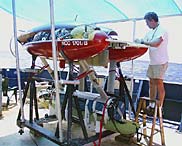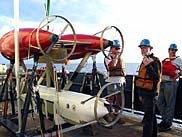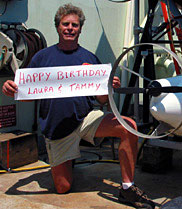|
|
|||||||||||||||||||||||||||||||||||||||||||||||||||||||||||||||||||||||||||||||||||||||||||||||||||
 |
|||||||||||||||||||||||||||||||||||||||||||||||||||||||||||||||||||||||||||||||||||||||||||||||||||
I'm often asked why is ABE shaped like the Starship Enterprise and not a more typical torpedo or submarine shape. There are two reasons. The first is stability. The two red upper pods contain almost all the floatation material that keeps ABE neutral in the water. Most of the weight is in the lower white pod. This makes it very difficult for ABE to pitch or roll. On a typical dive, when we're driving along, the pitch and roll variations are much less than a degree. This stability makes it very easy for the computer to control ABE's motion. It just doesn't have to "think" about roll and pitch, just yaw (which is left-right turning). It goes up and down like a helicopter, using its vertical thrusters, and doesn't pitch or roll. This also makes analysis of the sonar data much easier. If the sonar points its beam down, we know it stays pointed down. The most valuable data from ABE comes from the sonar maps its making, so it's important to know where the beams are pointed.
The second reason is to protect the vertical thruster blades by having them between the upper hulls where they can't get bumped into obstacles. Also, we have sometimes put lateral thrusters on ABE. There are two which mount on the right side aluminum struts at the places covered over now with black electrical tape. When we're just traveling forward, we leave these off because they cause extra drag which wastes battery energy. For some work we put these back on so ABE can go straight sideways as well as up and down, forward and back. This allows ABE to maneuver close to rough terrain much like a helicopter can fly close to buildings.
When we settled on this shape, we noticed the resemblance to the Starship Enterprise, so we painted "NCC1701/B" on the nose. (The "tail number" on the original Star Trek ship was NCC1701/A. At the time, a "B" version hadn't been seen on the series.) Another question people wonder about is why do we use airplane style propellers instead of more typical marine propellers. The reason is we have a very limited energy supply, and have to use very efficient thrusters. The way to do this is to use a large diameter propeller.
Boats and ships know this trick also, but they are facing other limitations on prop size. On an ocean going ship, the propeller blades must not extend below the keel, for example. For ABE, we wanted a hull shape that would let us use as large a diameter as possible. The next problem is where to get the propellers. It turns out people make some really big model airplanes, and hobby stores can get the sizes we wanted. Our tests show that these are surprisingly efficient. Last, you might wonder why the bottom hull of ABE looks like it's not finished. It isn't! Poor ABE looks like C3PO with out his skin plates. We just didn't have time or money to get the hull skins made after we put the latest fancy sonar in the keel. I keep hoping someday we will get this finished, but so far, we just keep hanging more and better sensors on instead and live with the awful drag. |
|||||||||||||||||||||||||||||||||||||||||||||||||||||||||||||||||||||||||||||||||||||||||||||||||||



